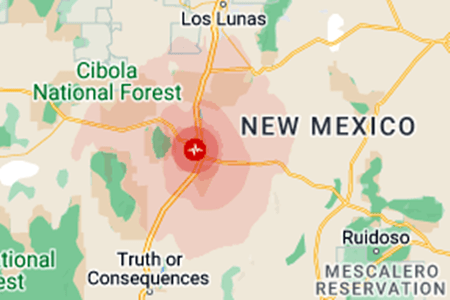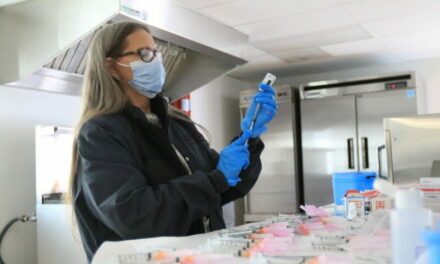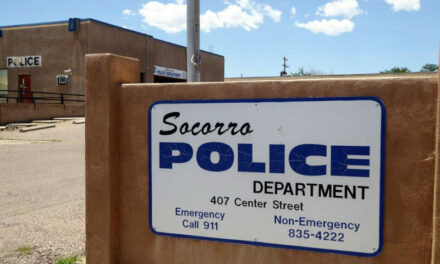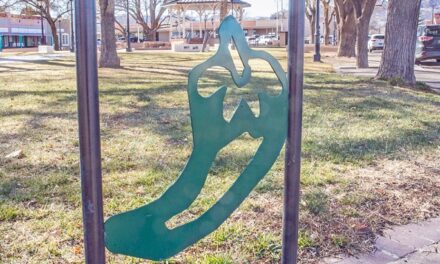
Courtesy US Geologic Survey
A 3.6 magnitude earthquake was reported southwest of Luis Lopez Thursday morning by the United States Geologic Survey.
The earthquake was measured at a depth of 6.3 kilometers, and no damage was reported by USGS.
While Socorroans don’t feel earthquakes every day, the Socorro area is the most naturally seismically active area in the state of New Mexico. That’s because of the magma body sitting 12 miles below the surface.
“If you look at the historical record, usually every couple of years we will get an earthquake of this size,” said Mairi Litherland, manager of the New Mexico Tech Seismological Observatory.
The most recent earthquake of this size was in 2017 when there was a 3.8 magnitude earthquake on the north side of the Socorro Magma Body near La Joya. Typically, events are too small for people to feel, a magnitude 1 or 2.
Socorro is also the site of the largest historic earthquake in the state—a 1906 quake with a 6 or 6.2 magnitude. The paleoseismic records offer a glimpse at an even bigger quake in the state.
“When geologists look at faults and see the slip that happened thousands, 10s of thousands, even 100s of thousands of years ago, there are some paleo events that are estimated to be around magnitude 7 that may have happened in New Mexico,” said Litherland. “We just haven’t had one in recorded history.”
The Socorro Magma Body is large and deeper than usual, and GPS measurements show that it is slowly expanding over time by a couple millimeters per year. That inflation causes stress in the crust. Monitoring the magma body is the reason the seismic monitoring program Litherland works for was established in the 1960s, although the program has recently established monitoring locations in other parts of New Mexico, like the Permian Basin where they monitor induced seismicity.
“We continue to run our Socorro network because aside from the induced seismicity, Socorro is the most seismically active part of New Mexico,” said Litherland. “Every few years, we get an earthquake that’s size 3 or so, which is usually the threshold where people are able to feel these events, although usually at that level there’s little or no damage from the earthquake.”
Magnitudes are a quantitative measurement of how much energy an earthquake releases, but the amount of damage or shaking caused by an earthquake doesn’t just depend on magnitude. It’s affected by other factors like the geology of the area.
“Some rocks or types of soils can amplify the seismic wave whereas other ones will attenuate the seismic waves more quickly. When we talk about earthquakes causing damage, instead of magnitude, we refer to intensity,” said Litherland.
Damage to structures and loss of life are also affected by building codes.
“In some poorer countries that don’t have as good of building codes, magnitude 6 events have caused tremendous amounts of damage and destruction and deaths. Typically, in areas with strong buildings and modern building codes, magnitude 6 will cause some damage,” said Litherland, but are less likely to lead to deaths or serious structural damage.
“When I talk about earthquake hazard in New Mexico, it’s a little bit of a difficult subject, because the chance of a very large damaging earthquake happening in New Mexico in our lifetimes even is actually quite low,” said Litherland. “It’s estimated that the recurrence interval for these very large earthquakes is in the thousands of years, but we do know from the records that it is possible to have an earthquake that size.”
Although the risk is small, she still encourages people to know what to do if an earthquake happens. The steps are drop, cover and hold on.
“If you’re able to do so, drop to the ground, take cover under a desk or a table if you can and hold on to secure yourself in place. Then it’s always a good idea to have an emergency kit.”
Induced Seismicity
“There’s actually a wide variety of human activities that can cause seismicity, from mining explosions to certain geothermal energy production, dams and reservoirs cause changes in the stress of the earth that can cause quakes,” said Litherland. “But in New Mexico commonly, in other parts of the country and the world, the most common induced seismicity that we see in the present is caused by oil and gas production.
“In terms of the modern production techniques, the oil production involves extracting a lot of fluid along with the oil and that fluid has to be reinjected into the subsurface. When that happens, depending on a lot of factors, it can depend on the existing stress state, how close you are to the fault, stuff like that, it is known to trigger seismic events.”
Such induced seismicity was seen in the early 2010s in Oklahoma, she said.
“A state that historically experienced basically no naturally occurring tectonic seismicity suddenly started having hundreds and thousands of earthquakes per year—including a few that were over magnitude 5, that were able to be felt and cause some minor damage.”
In the early 2000s, New Mexico saw areas with induced seismicity. That declined a little, but there’s been an increase in the number of earthquakes in the past few years, she said. A 2021 magnitude 4 event led the Oil Conservation Division to implement new regulations that enable them to ask companies to reduce injection in areas that allow seismicity.

















